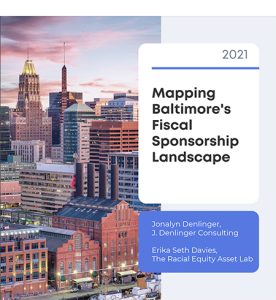Many of you may be familiar with the COVID Conversations, weekly remote sessions hosted by Andrew Schulman and Oliver Hack, that began in 2020 and now continue as Fiscal Sponsor Conversations. These Tuesday meetings offer expert aid and mutual aid to those managing fiscally sponsored projects throughout the country.
I was intrigued by a session in September featuring the authors of a 2021 study, “Mapping Baltimore’s Fiscal Sponsorship Landscape.” I’ve always thought that a local inquiry into the existence and health of fiscal sponsorship in a particular community can be very revealing and useful to understanding the challenges facing the field there — and in many other places.
The Baltimore study, done by J. Denlinger Consulting and The Racial Equity Asset Lab, is available online.
Several major funders commissioned this landscape analysis with the goal of “increasing investment in Black, Indigenous and People of Color (BIPOC) leaders and innovative organizations … without 501(c)(3) status.”
“It’s important to know enough about what went wrong [in Baltimore] to deduce lessons for future best practices”
It identifies five “key takeaways” as well as short-, mid-, and long-term recommendations with strong implications not only for Baltimore but also for large and small communities elsewhere.
“The ecosystem is fragile and overextended,” the report warns, in conclusion. “Without investment and commitment from funders and buy-in from all stakeholders, the ecosystem is neither sustainable nor able to meet the essential needs of all stakeholders.”
These are my observations and thoughts:
1. The report refers to “the loss of a long-standing fiscal sponsor in Baltimore,” mentioning its name only in passing. I can understand the sensitivities of commenting on the misfortunes of a struggling organization, but it’s important to know enough about what went wrong to deduce lessons for future best practices. Some insight is contained in a 2020 Baltimore Sun article.
About once a decade, we hear about a major or partial collapse by an over-extended fiscal sponsor operation. The 3rd edition of Fiscal Sponsorship: 6 Ways To Do It Right, pages 93 and 94, describes how the International Humanities Center situation led to California legislation installing an annual system to notify the state attorney general if the organization’s balance sheet shows that it is over-extended, endangering its projects and requiring corrective action. So, should Baltimore or Maryland have a similar early-warning system? Might this have caught the problems with Strong City sooner?
2. First among the report’s short-term recommendations is a call to funders to pay the fiscal sponsor fees above and beyond the grant. I wholeheartedly support this. In fact, where the sponsor has a 10% fee, the advice I like to give a donor-advised fund is to make the terms of the grant “$20,000 for the XYZ project, plus $2,000 for fiscal sponsorship.” (Yes, I realize that is only 9.1% of the total $22,000 grant mathematically, but no one complains: The project gets the full amount of the grant it expected, and the sponsor gets the fee it expected if the funder hadn’t paid the fee on top.) This is a good way to get funders to notice and accept the value of the sponsorship service.
3. A long-term report recommendation is to revise the grant disbursement policies of public funds, which burden projects and sponsors causing them to front the costs of operating before those costs are reimbursed by the government agency. The study suggests that the public grant include a percentage of funds upfront so the program can launch immediately.
However, it may be difficult to convince government sources to alter long-standing reimbursement policies meant to control and justify spending taxpayer dollars. A better solution might be for sponsors to establish a line of credit-like program-related investment account with a local community foundation, for instance. That way, if a project qualifies for a government grant, the sponsor could obtain a no-interest loan, repayable to the community foundation when the reimbursement comes through.
4. Finally, the report lists 25 fiscal sponsors serving Baltimore that were identified during the study (page 18). I saw only one university-based sponsor, University of Maryland, Baltimore County, and no public health institutions. And what about those general-purpose fiscal sponsors based outside of Baltimore with a national or international reach? I saw a few: Players Philanthropy Fund, Equity Matters, and perhaps others, but where is United Charitable? Fractured Atlas? New Venture Fund? Catholic Charities? Are they already active in Baltimore, or could they be looked to for help?
My impression is that there are very large 501(c)(3) organizations, such as universities, public health institutes, religious organizations, and community foundations, that operate substantial fiscal sponsorship programs without realizing it. Some do very well, charging fiscal sponsorship fees as high as 40%. They could be part of a widespread charitable service world, but they are still within their own silos. They could share expertise and resources with struggling and marginalized community groups such as those in Baltimore.
In these critical times, with deepening inequities in the face of planetary challenges, if we are “all in this together,” it is about time we recognized the common tools we could use to survive — and thrive.
The for-profit world has its private venture capital.
In our not-for-profit world, fiscal sponsorship gives us access to public and charitable capital.
Let’s use it.